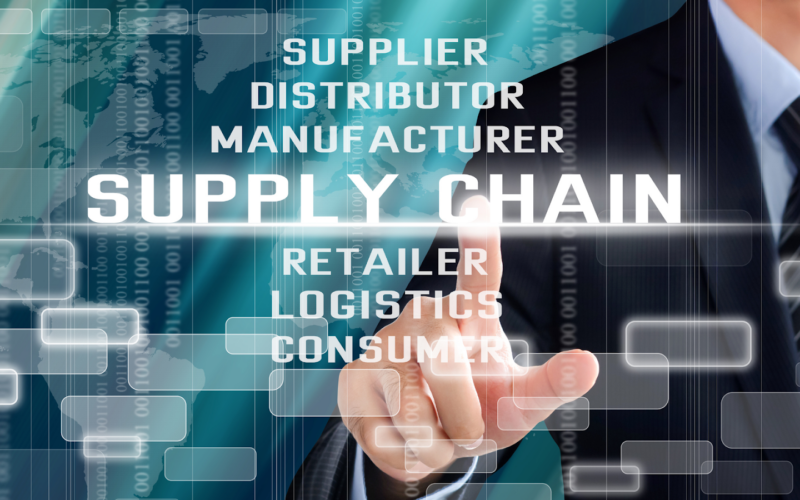Rising demands, global disruptions, and the need for speed are putting pressure on supply chains. Businesses using manual or siloed systems face delays, high costs, and poor visibility. That’s why many are turning to digital supply chains for smarter, connected operations.
The global digital supply chain market was valued at USD 5.44 billion in 2024 and is expected to grow at a 12.90% CAGR, reaching around USD 18.30 billion by 2034. This trend shows more businesses are investing in real-time data, automation, and visibility to stay competitive.
In this blog, you’ll learn exactly what a digital supply chain is. We’ll cover its core components and key benefits. The blog also shares strategies and common implementation challenges with solutions.
If you’re a CFO, operations leader, or key decision-maker, this blog shows how a digital supply chain boosts resilience, control, and competitiveness.
TL;DR
- A digital supply chain uses AI, IoT, cloud, and analytics to connect and optimize every part of your supply network in real time.
- Core components include predictive analytics, automation, real-time tracking, data integration, and cybersecurity.
- Businesses see measurable gains, faster decisions, lower costs, improved visibility, and stronger risk control.
- A successful transformation requires clear objectives, smart prioritization, and strong leadership buy-in.
- Challenges like high costs, system integration, and change resistance can be overcome with phased planning and continuous improvement.
What Is a Digital Supply Chain?
A digital supply chain is a fully connected, tech-enabled system that lets you manage every part of your supply network using real-time data, automation, and smart tools. Instead of manual processes and siloed systems, a digital supply chain uses AI, IoT, cloud, and analytics to connect suppliers, logistics, and customers in one smart network.
In a digital setup, data flows instantly between departments and partners. For example, custom-built digital platforms can automate inventory updates in real time, track order status across a central dashboard, and streamline billing through integrated apps. With the right software, teams no longer need to rely on spreadsheets or manual inputs, everything from stock levels to deliveries can be managed through one connected system, improving speed, accuracy, and decision-making.
Also Read: How Agentic AI is Transforming Supply Chains
While the concept gives a high-level view, it’s the underlying components that determine how effectively a digital supply chain performs in practice.
Core Components of Digital Supply Chain Management
To build an efficient and future-ready supply chain, it’s important to understand the key technologies and systems that power it. The following are the core components of digital supply chain management that help your business operate smarter, faster, and with greater financial control.
1. Data Analytics
Data is at the heart of every digital supply chain. Advanced analytics tools help you turn raw numbers, like sales data, supplier performance, and shipping timelines, into clear, useful insights. This allows your team to forecast demand more accurately, plan inventory smarter, and spot patterns before they become problems. For finance leaders, this means fewer write-offs, more predictable cash flow, and tighter control over working capital.
2. Internet of Things (IoT)
IoT devices like smart sensors and GPS trackers provide live updates on shipments, warehouse conditions, and machine health. But to make that data truly useful, businesses need IoT-integrated software platforms that collect, process, and visualize this information in real time. With custom-built applications tailored to specific workflows, teams can easily monitor inventory, detect equipment issues early, and manage deliveries from a single dashboard, reducing manual checks and improving operational efficiency.
3. Artificial Intelligence (AI) and Machine Learning (ML)
AI and machine learning take your data and use it to make better decisions automatically. Whether it’s predicting future sales, choosing the fastest delivery route, or balancing stock between locations, AI helps your team respond quickly without guesswork. For CFOs, it leads to better margins, less waste, and stronger customer service metrics, all of which are measurable.
4. Cloud Platforms and System Integration
When your systems are connected through the cloud, everyone, from procurement to logistics to finance, is working with the same up-to-date information. You don’t have to chase spreadsheets or send endless emails for status updates. Everything is in one place, easy to access, and automatically updated. This cuts delays, improves team coordination, and helps you make decisions faster.
5. Blockchain Technology
Blockchain creates secure, digital records of every transaction in your supply chain. That includes supplier contracts, product movement, and delivery confirmations. Because these records can’t be changed, you get full traceability and trust throughout the chain. It’s especially useful if you’re in a regulated industry or need to prove compliance during audits or recalls.
6. Automation and Robotics
Automated systems handle repetitive and time-consuming tasks like picking, packing, sorting, or sending out invoices. In warehouses, robots can move goods quickly and accurately. In your back office, software can automate invoice approvals or purchase orders. This speeds up operations, reduces human errors, and saves on labor costs, without sacrificing accuracy.
7. Cybersecurity
As your supply chain becomes more digital, protecting your data is critical. A good cybersecurity setup protects your financial data, customer information, and supplier contracts from breaches or cyberattacks. For business leaders, this isn’t just an IT issue, it’s about protecting your reputation, avoiding legal trouble, and ensuring smooth business operations.
8. Real-Time Collaboration Tools
These tools help your internal teams and external partners stay on the same page. Everyone can see order status, delivery schedules, and inventory levels at the same time. It makes coordination easier, reduces miscommunication, and speeds up issue resolution, especially during supply chain disruptions.
9. End-to-End Visibility
End-to-end visibility means knowing where every item is in your supply chain, from supplier to warehouse to customer. With live dashboards and tracking tools, you can quickly identify delays, stock shortages, or risks. This kind of transparency helps you reduce uncertainty, avoid penalties, and keep your customers satisfied.
10. Vendor and Supplier Management
Digital tools make it easier to manage your suppliers, track performance, communicate faster, and evaluate risk. You can see who’s delivering on time, who’s missing deadlines, and who may need to be replaced. This helps you negotiate better contracts and ensures your supply chain stays strong even if one vendor fails.
11. Accounts Payable and Receivable Automation
Automating your AP/AR processes helps you manage cash flow more effectively. Invoices get processed faster, errors are reduced, and you can take advantage of early payment discounts. This also improves your ability to forecast cash, stay compliant, and support your financial planning with real-time data.
Struggling to make your supply chain more efficient and responsive?
At Codewave, we build custom IoT-enabled platforms and AI-powered software solutions that help you streamline complex supply chain operations. From real-time inventory tracking to intelligent forecasting and process automation, our solutions are tailored to your business needs.
Let’s explore how we can build the right digital tools for you.
Schedule a call with our team today!
Technology alone doesn’t create value; it’s how these components work together that drives meaningful outcomes. Next, let’s explore those benefits.
Benefits of Digital Supply Chain Transformation
Transforming your supply chain with digital technology goes far beyond replacing paper with screens; it’s about building a smarter, faster, and more responsive operation that supports real business goals. Here’s how digital transformation delivers real, outcome-driven value:
1. Real-Time Visibility and Transparency
You get instant access to live data from across your supply chain, inventory levels, shipment locations, and supplier updates, all in one place. This lets you track what’s happening right now and respond quickly if something goes off track. For example, if a shipment is delayed, you’ll know immediately and can reroute or notify customers before it affects delivery.
2. Lower Costs and Higher Profit Margins
Digital systems cut out repetitive manual work, like data entry and paper-based approvals, which lowers labor costs and reduces errors. Predictive tools help you keep just the right amount of inventory on hand, so you’re not tying up cash in excess stock or missing out on sales due to shortages. You can also track spending more precisely and find areas where costs are leaking.
3. Smarter and Data-Backed Decisions
When your supply chain is digital, you can use data to guide every decision. Machine learning and analytics tools help you forecast demand, pinpoint bottlenecks, and plan shipping routes more efficiently. You stop relying on outdated reports or gut feeling, and start making choices backed by real-time insights.
4. More Flexibility and Risk Readiness
A digital supply chain can quickly adapt when something changes, whether that’s a spike in demand, a supplier issue, or a market shift. You can also run different scenarios in advance (“what if a supplier fails?” or “what if fuel prices rise?”) so you’re ready with a plan before problems happen.
5. Stronger Supplier and Partner Collaboration
Digital tools let you share data and updates directly with your vendors, logistics teams, and customers. This helps reduce delays, improve coordination, and onboard new partners faster with standard digital processes. Everyone works from the same live information, no more email chains or spreadsheet confusion.
6. Better Risk and Compliance Control
With everything tracked digitally, you’ll have a clear audit trail and compliance records ready when needed. Automated systems can also flag risks in advance, like a vendor repeatedly missing deadlines or a shipment held at customs, so you can step in before the issue grows.
7. Faster Product Launches and Innovation
When your workflows are digital, launching new products becomes quicker and smoother. You can test ideas faster, cut down approval time, and move from planning to delivery without roadblocks. This supports continuous improvement across the board, less waste, more speed, and better performance.
8. Measurable Sustainability Impact
Digital supply chains help you cut waste and track your environmental footprint in real time. Whether it’s optimizing delivery routes to reduce fuel use or tracking carbon output across suppliers, you get accurate data to support ESG reporting and meet corporate responsibility goals.
Also Read: AI Usage to Transform Supply Chains and Logistics
Understanding the benefits is one thing, delivering them consistently is another. That’s where a well-planned, outcome-driven transformation strategy makes all the difference.
Strategies for Successful Digital Supply Chain Transformation
Making the shift to a digital supply chain takes more than investment; it requires a clear sense of direction, cross-functional alignment, and a strategy built around real operational needs. Below are the key pointers that can help guide your transformation from planning to execution.
1. Evaluate Your Current Supply Chain Capabilities
Start by reviewing your current operations in detail. Look at the tools you’re using, how your teams work, and where the delays or inefficiencies are happening.
- Are your processes still paper-based or dependent on emails and spreadsheets?
- Do your systems talk to each other, or are they siloed?
This honest assessment helps you identify weak spots, technology gaps, and areas with the highest potential for digital upgrades. It’s your baseline for building a realistic transformation roadmap.
2. Define Clear Goals That Tie to Business Outcomes
Don’t just aim for “digital transformation”, set specific, measurable goals that link directly to business performance.
For example:
- Shorten average delivery times to improve customer satisfaction.
- Increase order accuracy to reduce returns and rework.
These goals help keep your strategy grounded in results that matter to finance, operations, and customer success. Make sure every objective supports your broader company goals.
3. Focus on High-Impact, Quick-Win Areas First
Start where you can deliver visible value fast. This builds momentum and makes it easier to get buy-in across departments.
Examples include:
- Automating inventory tracking.
- Using AI for better demand forecasting.
- Implementing real-time shipment visibility.
Use a phased roadmap: balance short-term gains with long-term projects. This helps you manage change more effectively without overwhelming your team.
4. Promote a Digital-First Mindset Across Teams
Digital transformation only works if your people are ready for it. Encourage teams to adopt new tools and workflows.
- Offer hands-on training and upskilling programs.
- Support cross-functional collaboration.
- Make it clear that leadership backs this change.
When your people are engaged and confident, you reduce resistance and increase the success of your digital initiatives.
5. Invest in Real-Time Visibility and Partner Collaboration
Visibility is the foundation of a responsive supply chain.
- Use IoT sensors, GPS tracking, and RFID to get live updates on shipments, inventory, and assets.
- Implement shared dashboards so partners, suppliers, and internal teams see the same data.
This transparency helps you identify issues early, avoid delays, and make faster, better decisions across the supply chain.
6. Automate Repetitive Tasks and Optimize Critical Processes
Manual processes slow you down and leave room for errors. Automate where it counts.
- Automate order processing, invoice handling, and inventory updates
- Use AI and machine learning to predict demand shifts, optimize logistics, and flag potential disruptions.
- Adopt cloud platforms to integrate all systems and scale as your business grows.
Automation not only saves time, it frees up your teams to focus on strategic work that drives growth.
7. Strengthen Risk Management and Resilience
In today’s unpredictable environment, your supply chain must be able to handle shocks, whether that’s a supplier issue, transport delay, or regulatory shift.
- Use digital tools to track risk in real time.
- Build “what-if” models to prepare for different disruption scenarios.
- Create alternate sourcing or routing plans to stay agile when things go wrong.
This proactive approach ensures business continuity and protects customer satisfaction.
8. Track Performance, Measure ROI, and Keep Improving
Transformation isn’t a one-time project, it’s an ongoing process.
- Set clear KPIs like inventory turnover, fill rate, cost per shipment, and customer delivery times.
- Monitor performance continuously with visual reporting and real-time data.
- Keep an eye on performance over time and adjust your strategy when needed, so it stays aligned with your changing business goals.
Measuring what matters helps you prove ROI, justify further investments, and continuously improve efficiency and outcomes.
Have a digital strategy, but not sure how to scale it across your supply chain?
From IoT integration to predictive analytics, Codewave builds and maintains scalable solutions that grow with your business.
Strategy gives direction, but implementation is where things get tested. Let’s take a closer look at the most common obstacles businesses face along the way.
Challenges in Digital Supply Chain Implementation
Transforming your supply chain with digital tools can unlock major advantages, but getting there isn’t without its challenges. Many businesses struggle to balance the technical, operational, and cultural changes required. Below are some of the most common challenges and the practical ways to overcome them.
1. High Upfront Costs Can Slow Down Buy-In
Implementing technologies like AI, IoT, and cloud platforms comes with a heavy upfront investment. Budget constraints can make it difficult to justify the spend, especially without a clear path to ROI.
The solution:
Don’t try to do everything at once. Take a phased approach, prioritize use cases that deliver quick wins, like real-time inventory tracking or demand forecasting. Start small, prove the value early, and reinvest from savings or efficiencies gained. This spreads out the cost, reduces risk, and builds executive confidence in scaling further.
2. Struggles with Connecting New Tech to Legacy Systems
Many companies still run on legacy software that wasn’t designed for integration. This can lead to disconnected data, broken workflows, and costly downtime during transitions.
The solution:
Choose modern solutions that are API-friendly and built for interoperability. Before you implement anything, assess the compatibility of your core systems, ERP, WMS, TMS, etc., and bring in integration experts who can map out the best way forward. This keeps your operations running while modernizing step-by-step.
3. Limited Real-Time Visibility Across the Supply Chain
As supply chains grow more global and complex, it becomes harder to track every moving part. Without visibility, your team may miss delivery delays, bottlenecks, or compliance issues until it’s too late.
The solution:
Invest in connected devices and real-time monitoring tools, like IoT trackers, RFID, and cloud-based dashboards. Layer on AI to interpret the data and highlight risks before they escalate. When you see everything as it’s happening, you’re in a better position to act fast and protect service levels.
4. Data Quality and System Fragmentation
Digital tools are only as good as the data feeding them. Inconsistent formats, outdated records, and isolated systems create noise that can misguide decision-making.
The solution:
Establish strong data governance from the start. Standardize your data formats, clean up legacy databases, and make sure all systems communicate using common protocols. Regular data quality checks and internal audits are essential for keeping your digital tools accurate and reliable.
5. Shortage of Digital Skills Within the Team
Today’s supply chain needs more than operational know-how, it demands digital literacy, data analysis, and tech fluency. Many organizations find that their teams aren’t prepared for the shift.
The solution:
Invest in training programs that match your digital strategy. Upskill current employees in areas like data interpretation, AI tools, and cloud systems. At the same time, hire talent with experience in digital supply chain operations. Partnering with universities or certification providers can help create a pipeline for long-term growth.
6. Resistance to Change Slows Down Progress
New systems and digital processes often meet internal resistance. Teams may worry about job security, learning curves, or just the hassle of change.
The solution:
Make change management part of your strategy, not an afterthought. Communicate clearly why the transformation matters, how it benefits the team, and what support will be provided. Involve employees early in the process and show leadership commitment from the top. A strong culture of transparency and learning is key to long-term adoption.
7. Pilot Projects Don’t Scale Well Across the Business
You may run a successful digital pilot in one part of the business, but struggle to replicate it elsewhere due to differences in processes, systems, or priorities.
The solution:
Design your pilots with scalability in mind. Bring in cross-functional teams to build and test processes that can adapt to different business units. Document lessons learned and refine the approach before scaling. Use internal champions to support rollout across departments and regions.
8. Sustainability and Compliance Requirements Add Complexity
With growing pressure to meet sustainability goals and stay compliant with evolving regulations, digital transformation becomes even more complex, especially with global supplier networks.
The solution:
Integrate sustainability tracking and compliance checks directly into your digital platforms. Use data to monitor supplier behavior, carbon emissions, and environmental certifications. Build scorecards to ensure each supplier meets your standards. This not only reduces regulatory risk but also improves your ESG performance and brand trust.
Is limited visibility or risk management holding your supply chain back?
At Codewave, we design and build custom solutions, integrated with IoT, analytics, and AI, that help you track assets in real time, predict issues before they occur, and drive smarter, faster decisions.
Tackling implementation challenges is easier when you have a team that’s done it before, at scale and across industries. Let’s take a look at how Codewave delivers on that front.
How Codewave Supports Digital Supply Chain Transformation?
Codewave brings deep expertise in building custom digital solutions that make your supply chain smarter, faster, and more resilient. With over 250 successful digitization projects across 15 countries, they understand what it takes to drive real business outcomes. Whether you’re just starting your digital journey or scaling your existing setup, Codewave’s solutions help you solve real-world supply chain challenges.
If you’re curious about how we approach complex problems, our portfolio highlights several case studies.
Here’s how Codewave can add value to your supply chain:
1. AI-Driven Forecasting and Automation
Codewave builds custom machine learning models that help you predict demand, optimize routes, and reduce delays. These solutions take the guesswork out of planning, so you can move faster and cut waste.
2. IoT Integration for Smarter Operations
Codewave connects IoT devices to your supply chain systems, giving you live updates on shipments, equipment, and inventory conditions. This real-time visibility helps you act quickly when things go off track.
3. Real-Time Data Insights and Business Intelligence
Codewave’s data analytics tools turn complex data from across your operations into clear, real-time dashboards. You get the insights you need to improve inventory decisions, manage supplier performance, and reduce costs, without relying on manual reports.
4. Conversational AI and Smart Chatbots
From customer service to supplier queries, Codewave’s AI-powered chatbots can handle routine questions 24/7. This reduces workload on your team and keeps operations running smoothly around the clock.
5. MLOps and Model Maintenance
They don’t just build AI models; they help you maintain them. With MLOps consulting, Codewave ensures your predictive tools stay accurate over time through automated monitoring and updates.
6. Image, Video, and Voice Intelligence
Using tools like object tracking, facial recognition, and voice commands, Codewave helps you improve warehouse security, speed up order verification, and enable hands-free operations, ideal for logistics, retail, and field teams.
7. Generative AI for Efficiency
Need to automate repetitive tasks like documentation or reporting? Codewave’s generative AI tools help you save time by creating smart summaries, workflows, and updates with minimal manual effort.
8. NLP and Text Intelligence
They also help you unlock insights from unstructured data, like supplier emails, feedback, or logistics notes. This helps you catch potential issues early and find trends that might otherwise be missed.
9. Predictive Risk Management
By analyzing historical data, Codewave helps you build models that flag risks, like late shipments or quality issues, before they happen. This allows you to act early and avoid costly disruptions.
10. Scalable, Self-Learning AI Systems
As your business grows, your models improve. Codewave’s systems are built to learn from new data, so they get smarter over time, adapting to changes in demand, supplier behavior, and market trends.
If you’re exploring ways to modernize your supply chain with AI, automation, or real-time data insights, our team at Codewave is here to help. We’ll work with you to understand your challenges and design solutions that align with your business outcomes.
Start a conversation with us today!
Frequently Asked Questions (FAQs)
1. How can data analytics improve supply chain operations?
Data analytics turns raw information into useful insights. You can use it to track supplier performance, forecast demand more accurately, and make better buying decisions. It helps you identify patterns, reduce excess inventory, and lower holding costs, giving you more control over both operational and financial outcomes.
2. Why does real-time collaboration matter in supply chains?
When your suppliers, partners, and internal teams work from the same real-time data, decision-making becomes faster and more accurate. Real-time collaboration minimizes delays, reduces back-and-forth communication, and ensures that everyone is aligned, even during unexpected disruptions. This level of transparency keeps your operations agile and your customers happy.
3. What value does cloud computing bring to my supply chain?
Cloud platforms allow your team to access up-to-date supply chain data anytime, from anywhere. Whether you’re tracking inventory across multiple sites or managing supplier contracts, cloud-based systems streamline your workflows, support remote collaboration, and scale easily as your business grows.
4. How do automation and robotics make a difference?
Automation tools and robotics reduce manual labor, speed up order processing, and cut down on errors in tasks like picking, packing, and invoicing. This helps reduce operational costs and frees up your team to focus on higher-value, strategic work that moves the business forward.
5. Why is cybersecurity a priority in digital supply chains?
With more systems connected digitally, your supply chain becomes more exposed to cyber threats. Cybersecurity protects sensitive business data, financial records, and supplier information from attacks. Investing in encryption, user access controls, and regular security audits helps protect your operations and reputation.
Codewave is a UX first design thinking & digital transformation services company, designing & engineering innovative mobile apps, cloud, & edge solutions.






